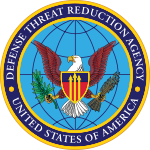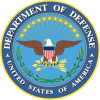- Defense Threat Reduction Agency
-
Defense Threat Reduction Agency 
Seal 
Logo Agency overview Formed October 1, 1998 Preceding agencies Defense Special Weapons Agency
Defense Nuclear AgencyHeadquarters Fort Belvoir, Virginia Employees 2,000 Website www.dtra.mil The Defense Threat Reduction Agency (or DTRA) is an agency within the United States Department of Defense and is the official Combat Support Agency for countering weapons of mass destruction (chemical, biological, radiological, nuclear, and high explosives). DTRA's main functions are threat reduction, threat control, combat support, and technology development. The agency is headquartered in Fort Belvoir, Virginia. DTRA employs 2,000 civilian and military personnel at more than 14 locations around the world, including Russia, Kazakhstan, Azerbaijan, Uzbekistan, Georgia, and Ukraine.
DTRA was established in 1998 by consolidating several DoD organizations, including the Defense Special Weapons Agency (successor to the Defense Nuclear Agency) and the On-Site Inspection Agency as a result of the 1997 Defense Reform Initiative.[1]
In 2005, the Secretary of Defense (SECDEF) made the decision to designate the Commander, U.S. Strategic Command (STRATCOM) as the lead Combatant Command (COCOM) for the integration and synchronization of DoD’s Combating WMD (CWMD) efforts in support of U.S. Government objectives. To fill this requirement, the USSTRATCOM Center for Combating Weapons of Mass Destruction (SCC-WMD) was collocated with DTRA.
Annual published budgetary figures are $346MM (FY 2008), $354MM (FY 2009), and $385 (est. for FY 2010).[2]
DTRA's vision is "to make the world safer by reducing the threat of weapons of mass destruction."
Contents
History
 Ukrainian workers use equipment provided by the DTRA to dismantle a Soviet-era missile silo.
Ukrainian workers use equipment provided by the DTRA to dismantle a Soviet-era missile silo.
After the end of the Cold War, DTRA and its predecessor agencies have implemented the DoD aspects of several treaties that assist former Eastern Bloc countries in the destruction of Soviet era nuclear, biological, and chemical (NBC) weapons sites (such as missile silos and plutonium production facilities) in an attempt to avert potential weapons proliferation in the post-Soviet era as part of the Nunn-Lugar Cooperative Threat Reduction (CTR) program.
DTRA is also responsible for reducing the threat of conventional war, especially in Europe, by participating in various arms control treaties to which the United States is a party, such as the Conventional Forces in Europe treaty and the Treaty on Open Skies.
In 2002, DTRA published a detailed history of its predecessor agencies, Defense’s Nuclear Agency, 1947–1997, which is in the public domain. The first paragraph of the preface makes the following brief statement about the agencies which led up to the formation of DTRA.
- "Defense’s Nuclear Agency, 1947–1997, traces the development of the Armed Forces Special Weapons Project (AFSWP), and its descendant government organizations, from its original founding in 1947 to 1997. After the disestablishment of the Manhattan Engineering District (MED) in 1947, AFSWP was formed to provide military training in nuclear weapons’ operations. Over the years, its sequential descendant organizations have been the Defense Atomic Support Agency (DASA) from 1959 to 1971, the Defense Nuclear Agency (DNA) from 1971 to 1996, and the Defense Special Weapons Agency (DSWA) from 1996 to 1998. In 1998, DSWA, the On-Site Inspection Agency, the Defense Technology Security Administration, and selected elements of the Office of Secretary of Defense were combined to form the Defense Threat Reduction Agency (DTRA)."[3]
On January 26, 2006, the director of DTRA was given the extra responsibility of the director of the USSTRATCOM Center for Combating Weapons of Mass Destruction (SCC WMD), a subordinate component to the United States Strategic Command (USSTRATCOM). [4]
DTRA has the responsibility to manage and integrate the Department of Defense chemical and biological defense science and technology (S&T) programs.[5] In accordance with the Recommendation 174 (h) of the 2005 Base Closure and Realignment Commission (BRAC), the Chemical Biological Defense Research component of the Defense Threat Reduction Agency is to be re-located to Edgewood Chemical Biological Center, Aberdeen Proving Ground, MD by September 30, 2011. [6] DTRA plans to build space for 15 personnel at Aberdeen Proving Ground.[7] This represents a move of about ten percent of the staff of the Chemical Biological Defense Research component of DTRA to Aberdeen Proving Ground; the rest of the staff remain at Fort Belvoir.
Publications
DTRA sponsors the journal WMD Insights.
'The Shield' is the official magazine of the DTRA SCC-WMD; printed quarterly. [8]
See also
References
- ^ "Department of Defense Reform Initiative Directive #6 - Appointment of the Team to Create the Defense Threat Reduction and Treaty Compliance Agency". Office of the Secretary of Defense. 3 December 1997. http://www.defense.gov/dodreform/drids/drid6.htm. Retrieved July 30, 2011.
- ^ "Operation and Maintenance, Defense-Wide Fiscal Year (FY) 2010 Budget Estimates". DTRA. May 2009. http://comptroller.defense.gov/defbudget/fy2010/budget_justification/pdfs/01_Operation_and_Maintenance/O_M_VOL_1_PARTS/DTRA.pdf. Retrieved April 18, 2011.
- ^ "Defense's Nuclear Agency, 1947–1997". DTRA History Series. 2002. http://www.dtra.mil/documents/aboutdtra/DefensesNuclearAgency.pdf. Retrieved October 9, 2010.
- ^ "Responding to War, Terrorism and WMD Proliferation: History of DTRA, 1998 – 2008". DTRA History Series. 2008. http://www.dtra.mil/documents/aboutdtra/RespondingTerrorandWMD.pdf. Retrieved September 21, 2011.
- ^ "DoD Directive 5160.05e, Roles and Responsibilities Associated with the Chemical and Biological Defense (CBD) Program (CBDP)". DoD. October 9, 2008. http://www.dtic.mil/whs/directives/corres/pdf/516005p.pdf. Retrieved July 30, 2011.
- ^ "Appendix Q, Commission's Final Recommendations, page Q-82". DoD. September 8, 2005. http://www.brac.gov/docs/final/AppendixQ.pdf. Retrieved July 30, 2011.
- ^ "BRAC Implementation Package Description". DoD Comptroller. http://comptroller.defense.gov/defbudget/fy2007/budget_justification/pdfs/05_BRAC/BRAC_2005_Defense_Wide_Justification/28_DTRA_BRAC_2005.pdf. Retrieved October 1, 2011.
- ^ "The Shield". DTRA. http://www.dtra.mil/documents/news/SHIELD_FALL_2010_web.pdf. Retrieved September 21, 2011.
External links
- DTRALink, the official web site of the Defense Threat Reduction Agency
- Responding to War, Terrorism, and WMD Proliferation: History of DTRA, 1998–2008, DTRA History Series
- WMD Insights, DTRA supported journal
- "The Shield", DTRA's official magazine
- Defense's Nuclear Agency, 1947–1997, DTRA History Series
- CNTTR, The Center for NBC Threats, Technology Transfer, and Resources of the Defense Threat Reduction Agency
- ACE Center, The Assessment of Catastrophic Events Center of the Defense Threat Reduction Agency
Agencies under the United States Department of Defense Deputy Secretary of Defense 
Under Secretary of Defense
for Acquisition, Technology and LogisticsDirector, Defense Research and Engineering · Defense Advanced Research Projects Agency · Missile Defense Agency · Defense Contract Management Agency · Defense Logistics Agency · Defense Technical Information Center · Defense Threat Reduction Agency · Office of Economic Adjustment · Defense Acquisition University · Business Transformation AgencyUnder Secretary of Defense for Policy Under Secretary of Defense (Comptroller) Under Secretary of Defense
for Personnel and ReadinessDefense Commissary Agency · Department of Defense Education Activity · DoD Human Resources Activity · Military Health System · Uniformed Services University of the Health Sciences · Defense Equal Opportunity Management Institute · Office of the Chancellor for Education and Professional DevelopmentUnder Secretary of Defense
for IntelligenceService Departments Categories:- United States Department of Defense agencies
- Nuclear proliferation
- Government agencies established in 1998
Wikimedia Foundation. 2010.
